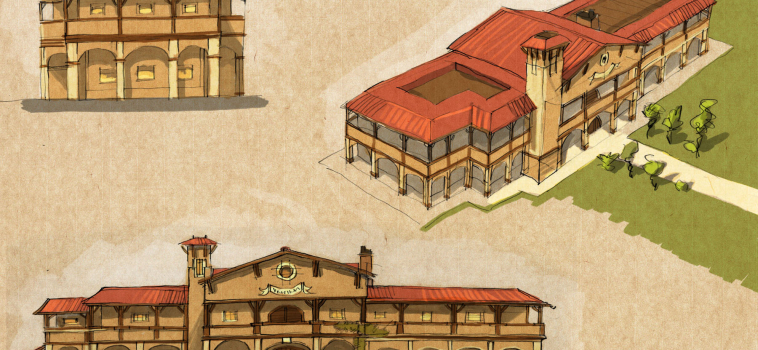Narrative Context that Works – Creating Immersive Learning Environment
Why Winery?
Why did we choose a Californian winery for the FLIGBY simulation? First, we needed a good story that captured people’s imagination. That’s essential for creating an immersive learning setup. But there is more to it.
Prof. Csikszentmihalyi himself proposed the subject of a winery back in 2008. He had two good arguments. First, the wine itself is already a “well-positioned” theme. Anyone who can consume a glass of wine with relish might also be opened to such great truths of life, like Flow. The other is a Hungarian relation. The Californian wine business was established by our adventurous compatriot Agoston Haraszthy in the 1850s, shortly after he resigned from his position as a Sheriff of San Diego, but right before a crocodile in South America had eaten him.
Immersive learning: people love good stories
It is a fact that people love to learn through stories. A good story is a building block for video games and “serious games” using professional game mechanisms to create basics for immersive learning. It is especially true in the interactive film genre. The narrative context has several significant psychological advantages that help keep people engaged:
- Business case studies work best as stories – We love to hear and tell stories. You can’t just give facts. For an immersive learning environment, it would be best if you placed them in the context of events sequenced with a beginning, middle, and end, some tension about how things will resolve, and detail about the people involved – that will engage audiences in something that becomes real because they can imagine themselves in the same narrative space.
- Narratives tell players what to do – Game narratives give players hints about what to do, which helps with execution and tactics applied to larger goals. Game stories are designed as unfinished frameworks where players complete the narrative by living it.
- Narrative increases Excitement and Attention – All good stories’ uncertainty creates excitement and tension that sustains player involvement. It focuses players on resolution and release (players attempt to reduce this excitement, especially if its source is a conflict).
- Stories are compelling – It’s easier to remember information when presented in a narrative format.
Learning responsible leadership from Californian wineries
Managing a company these days should be more than just giving out orders and expecting profit at the end of the month. As Prof. Csikszentmihalyi explains in his book “Good Business: Leadership, Flow, and the Making of Meaning”, those who pursue to build good business are creating an enjoyable work environment for their organization’s workers, through which a business’ (or any organization’s) “balanced scorecard” improves, thereby contributing to healthier and more sustainable societies at large. Californian winemaking can be a perfect example of good business through their sustainable wine-growing practices that these days are almost worldwide applied.
Business is now our most crucial institution, so it has an obligation to the quality of life not just of its employees, but also of society. Good Business reveals how business leaders, managers, and even employees can find “Flow” and contribute not only to their own happiness, but also to improved organizational performance as well as to a just and evolving society.
The importance of Californian winemaking dates back to the late 18th century when Spanish missionaries planted their first vineyards to produce wine for masses and also for daily life. Today there are about 4,400 vineries – even though the Prohibition law between 1919 and 1933 ruined about 90% of the industry – ranging from small, family-owned „boutiques” to large corporations. The reason that makes the coexistence of these many vineries possible is hidden in the geological diversity of the region, that varies from the Mediterranean to continental and also influenced by the pacific climate. Climate, soil, sun, and water combined with the knowledge, dedication, and attention to detail give the uniqueness and quality of these wines.
In the early 1990s winemakers and growers around the town of Lodi realized that in order to be able to grow healthy and high-quality grapes that produce delicious wines in the upcoming future, they must implement practices that preserve the environment (Environmentally Sound), contribute to the society (Socially Equitable) and are economically feasible to implement and maintain (Economically Feasible). The combination of these three practices is called sustainable practices.
These are the major considerations of the Sustainable Winegrowing Program of the California Wine Community:
- Produce the best quality wine grapes and wine possible
- Provide leadership in protecting the environment and conserving natural resources
- Support the economic and social wellbeing of farm and winery employees
- Respect and communicate with neighbors and community members
- Honor the California wine community’s entrepreneurial spirit
- Support research and education to expedite continual improvements
Sustainable Wine-growing
The California Sustainable Winegrowing Alliance (CSWA) as a nonprofit organization created in 2003 is a pioneer in promoting sustainable practices in the California wine community. Those vineries that are already implemented the Sustainable Winegrowing Program are taking action in conserving the water and energy, protecting air and water quality, enhancing relations with employees and communities, and preserving local ecosystems and wildlife habitat:
- Limited resources – Effective use of water that is an increasingly limited resource due to frequent drought in California is enormously important. Managing the effective usage of water has the greatest impact on wine quality. Energy efficiency is directly linked to the pumping of water.
- Awareness – Health of soil, water and air are the key elements of grape quality, that’s why it is a priority for growers to use sustainable practices to maintain a nourishing ecosystem. These practices include the reduction of pesticides by continuous awareness and monitoring of the field and also the preserve of biodiversity and wildlife.
- Community – Most California vintners and growers live nearby their vineyards and wineries meaning that their dedication to sustainability is more inevitable. Striving to provide a healthy environment by the preservation of natural landscapes, increasing the economic vitality by employment, volunteering opportunities and tourism are key elements of their engagement for the community and neighbors.
It is no coincidence that the story of the serious game FLIGBY takes place in a fine Californian vineyard, the Turul Winery. This scenery is a perfect background for taking such decisions that help coworkers to get into the flow and/or protect the environment, in other words: to acquire the practice of good business that includes sustainability.
My organization is not a winery. Do its problems apply to my business?
Still, the question arises quite often, how a fictional Californian winery is capable of modeling real leadership and organizational dilemmas. In other words: whether it is possible to build up an immersive learning field that is relevant for management challenges on an act that takes place in a winery. We are convinced that it is. We have five important arguments to prove it:
- The winery as a site is sufficiently abstract – if the simulation were played in a “normal office” (a site where most of the users spend a great amount of their time daily), people would be focusing primarily on the differences between the game and their own praxis. They would enlarge such details that could substantiate the differences between the reality of their daily experiences and the story of the simulation. This would significantly impede the recognition of essential correlations and the starting of experiential learning and experimenting. Therefore winery is a good site: people more or less know (or at least they think they know) what is going on at such place, so they accept the storyline and they focus on the conflicts highlighted by the simulation instead of unimportant details. Therefore the attention can be focused on a specific target.
- The story was inspired by real situations – all the organizational dilemmas presented in FLIGBY were inspired by real conflicts and common challenges that often occur in a multinational working environment. Our leading scriptwriter spent more than ten years in large enterprise environments, and his work was supported by an international team of professionals in leadership development. Prof. Csikszentmihalyi also played an active role in the finalization of the storyline and the characters and also in the development of the feedback system. So, the site is a winery but the organizational dynamics displayed in the game are much more general and commonly known.
- Microsimulation – FLIGBY is a microsimulation: it doesn’t model the whole professional operation of a winery, but only a portion of it that is focusing on the conflicts within the management. There are no economic or viniculture issues in the focus but rather such personal and organizational conditions that are needed for the development of such cooperation.
- “Edutainment” – Expectations towards leadership development are significantly changed over the last couple of years. The participants of company training became such “internal customers“ whose time is expensive and their needs are complex. They want practical and easily applicable knowledge, while the time spent in training cannot be boring, and also direct feedback and independent time schedule spent with learning must describe the immersive learning process. The winery environment shown in FLIGBY offers an exciting and entertaining form of learning, while the virtual interactions with the colleagues of the organization are realistic models of real workplace relationships.
- Managerial tasks are constantly transforming – Dealing with interesting things is becoming less privileged in today’s world. It’s rather an option that the network-based economy and project-oriented work organizations offer as a real alternative for more and more professionals. It is a popular intellectual challenge to learn about organizations that differ from the daily work routine and also serves as a strong motivation for studying.





